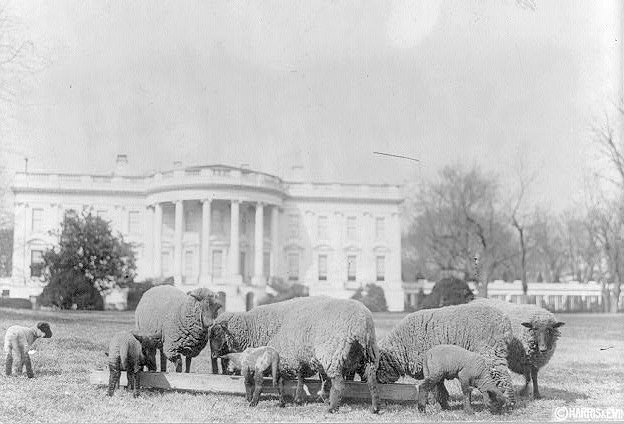Sheep and Wool
Sheep

- Sheep have been providing meat and clothing to people for over 10,000 years.
- Oklahoma is one of a few states that has year round forage production.
- Sheep usually live to be about eight years old.
- Sheep are very gentle animals and are easily frightened. They flock together for protection because they can't really protect themselves. The sheep has many natural predators, animals that hunt and kill sheep for food. They include coyotes, wolves and domestic dogs. Sometimes larger animals, like mules or llamas, are kept in the pastures with the sheep to scare off possible predators.
- The people that raise and care for sheep are called shepherds. Sometimes, shepherds have dogs to help take care of the sheep. The dog learns to round up the sheep, and when one wanders from the flock, the dog brings it back. When a lamb is born, the shepherd makes sure it gets off to a good, healthy start in life.
- Sheep have a 270-degree radius of view, almost 3/4 of a circle. Humans only see 170 degrees at best. This makes sheep very difficult to sneak up on or surprise. Sheep have poor eyesight but excellent hearing.
- Each sheep has it's own flight zone, the distance the sheep feels it needs to get away from danger. A sheep will not allow anything to come within it's flight zone.
- Sheep use various sounds to communicate different emotions and messages among flock members. A farmer can easily tell when a sheep is in pain or sick. A lamb can recognize its mother by her bleat.
- Each sheep is individual and unique and can distinguish between all other sheep. They can recognize fellow flock mates even after years of separation.
- Sheep would rather walk up-hill than down and would rather drink running water.
- Sheep have no front teeth, but the roofs of their mouths are hard. This permits sheep to eat vegetation close to the ground and prevents them from pulling up plant roots. Sheep have a split in their upper lip, with this they are able to pick the preferred leaves off the plant.
- There are many different breeds of sheep. Some are raised mainly for meat, and others primarily for their wool.
- Sheep are valuable because they often graze land that other livestock cannot. Sheep eat grass and hay.
- Sheep usually give birth once a year and have 1-3 lambs. Ewes typically give birth to twins. Sheep grow two teeth a year until they have eight.
- Female sheep are called ewes, baby sheep are called lambs, and male sheep are called rams. A group of sheep is called a flock. A one-year old sheep is called a hogget. A two-year old sheep is called a two-tooth.
- Sheep are also raised to provide meat. Lambs are ready for market when they weigh somewhere between 90-120 pounds. Lamb as food is an outstanding source of vitamins and minerals, and is one of the easiest to digest. The meat from a grown sheep is called mutton and that from a young sheep is called lamb.
- Sheep can be milked just like cows. Sheep milk is often used to make gourmet cheeses.
- The fat from sheep, also known as tallow, can be used to make both candles and soap. The tallow is cooked to purify it and then molded into candles or further prepared into blocks of soap.
- The small intestines from 11 sheep are needed to make one tennis racket.
- When Woodrow Wilson was President, the First Lady had sheep graze on the White House lawn to keep it neat and well trimmed.
Wool

- Sheep are usually shorn once a year. The sheep shearer uses a machine that is like the clippers used to trim a dog's fur.
- One sheep produces eight to ten pounds of wool per year, enough to make a man's suit. One pound of wool can make ten miles of yarn.
- Sheep are the only source of lanolin - grease that comes from wool before it has been washed. Lanolin is used in lotions and cosmetics.
- Wool straight from the sheep is called raw wool. Raw wool may go through more than 70 processing steps to assure that fabrics made from the wool are of the highest quality.
- Spinning wool into thread began about 5,000 years ago.
- One of the best things about wool fabrics is that they are flame resistant, so they are safer to wear. Wool also provides excellent protection from cold and wet weather. Even if your wool sweater gets wet from snow or rain, it will still keep you warm. Wool also wears well and lasts for a long time.
- The core of a baseball is wrapped with 150 yards of wool yarn.
- Race car drivers wear wool-lined suits to reduce their chances of being burned in a firey crash.
- Researchers in Pennsylvania have developed a biopolishing method that makes scratchy wool feel silky smooth. Not only does it remove the itch factor, it also bleaches the wool to a high level of whiteness and alters the surface of wool fibers to make them shrink-proof.
- The US military is interested in using biopolished wool, especially for manufacture of underwear for our troops. Underwear garments currently used contain synthetic fibers that can burn and melt into wounds during combat situations. Wool produces a self-extinguishing flame and dissipating ash when burned.
- Sponges made from wool soak up oil from oil spills. That oil can then be squeezed from the sponges and recycled; the sponges, too, can be used over and over again.
